LA COMMEDIA
DELL'ARTE
 Commedia
dell'Arte is the name given to the improvised, masked comedy which was popular
in Italy during the 1500's through the early part of
the Commedia
dell'Arte is the name given to the improvised, masked comedy which was popular
in Italy during the 1500's through the early part of
the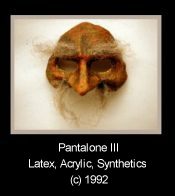 1700's. "Commedia" means "comedy,"
but "dell'Arte is more difficult to translate. Roughly, it means "of the
profession," and all the actors who took part were trained professionals,
some rising to great heights of fame through their work in Commedia
dell'Arte. 1700's. "Commedia" means "comedy,"
but "dell'Arte is more difficult to translate. Roughly, it means "of the
profession," and all the actors who took part were trained professionals,
some rising to great heights of fame through their work in Commedia
dell'Arte.
Although the actors worked
from established scenarios, each time the scenario was performed, it was
different, because the actors improvised, made up their lines, and altered
situations as they went along. The public could see the same "Commedia" many
times, and each time it would
be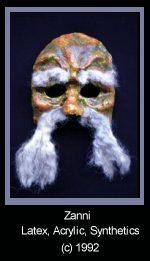 fresh and new. Commedia dell'Arte probably
originated during Carnival times in Southern Italy, but by the middle of
the 1500's, professional Commedia troupes could be found playing all over
Europe. fresh and new. Commedia dell'Arte probably
originated during Carnival times in Southern Italy, but by the middle of
the 1500's, professional Commedia troupes could be found playing all over
Europe.
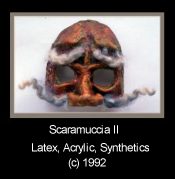 Each
actor in the troupe had their own special character, and played no other.
Because the action and dialogue were improvised, each actor had to know not
only the character played, but also a vast repertoire of monologues, quips,
jokes, and conceits, which the actors kept in what would today be called
a "gag book," and which was a priceless possession, handed down from generation
to generation. Each
actor in the troupe had their own special character, and played no other.
Because the action and dialogue were improvised, each actor had to know not
only the character played, but also a vast repertoire of monologues, quips,
jokes, and conceits, which the actors kept in what would today be called
a "gag book," and which was a priceless possession, handed down from generation
to generation.
Lovers, old men, and servants
were the main characters,
and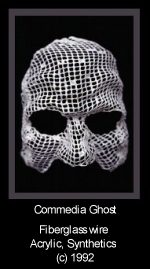 each character had his or her
special set of comedic traits, weaknesses, and foibles. Some of the favorite
characters were Pantalone, the learned, rich, sometimes greedy, and always
foolish merchant, cuckolded continuously by his wife; the each character had his or her
special set of comedic traits, weaknesses, and foibles. Some of the favorite
characters were Pantalone, the learned, rich, sometimes greedy, and always
foolish merchant, cuckolded continuously by his wife; the
 Doctor, always ardently eager for amorous adventure,
but also always the cuckold; and the Spanish Captain, the vain and pompous
braggart and swaggerer who constantly struts around, whirling his sword and
telling tales of his own magnificent glory, and who in the end is always
revealed as contemptible and cowardly. Stock characters also included the
philosophical and eternally melancholic Pulcinella; quick-witted Harlequin;
and Scaramouche, who uttered no words but said much, providing the model
for modern mime. Commedia dell'Arte was the common people's source of
entertainment. It was always hilariously slapstick, requiring great nimbleness
from the actors, and was frequently ribald. Doctor, always ardently eager for amorous adventure,
but also always the cuckold; and the Spanish Captain, the vain and pompous
braggart and swaggerer who constantly struts around, whirling his sword and
telling tales of his own magnificent glory, and who in the end is always
revealed as contemptible and cowardly. Stock characters also included the
philosophical and eternally melancholic Pulcinella; quick-witted Harlequin;
and Scaramouche, who uttered no words but said much, providing the model
for modern mime. Commedia dell'Arte was the common people's source of
entertainment. It was always hilariously slapstick, requiring great nimbleness
from the actors, and was frequently ribald.
For example, some of the stock
names used by the Captain were Spaccamonti (mountain-splitter), Cardone (big
thistle), or Culonero (black arse). Pantalone, the "first old man" of Commedia,
moved slowly, painfully bent over, and then in moments
of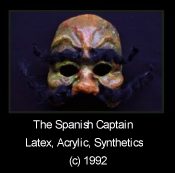
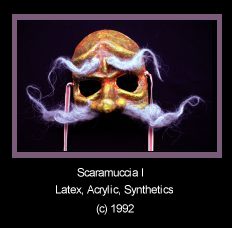 fury proved capable of performing astounding
feats of agility, followed by heavy panting and asthmatic breathing. Complex
and totally ridiculous backfalls were the forte of the actor who played
Pantalone. Yet, the scenes of Commedia always provided great intellectual
satire for the audience, frequently based on class distinctions, such as
the hypocrisy of the upper classes, class division itself, for which the
Zanni, or servants, provided counterpoint, expressing with knockabout mirth
the woes of the downtrodden. Other favorite themes forayed into the Seven
Deadly Sins, including gluttony, lust, vanity, and all the rest, turning
major concerns of the day into objects of ridicule to be openly looked at,
explored, laughed at, and then conquered. fury proved capable of performing astounding
feats of agility, followed by heavy panting and asthmatic breathing. Complex
and totally ridiculous backfalls were the forte of the actor who played
Pantalone. Yet, the scenes of Commedia always provided great intellectual
satire for the audience, frequently based on class distinctions, such as
the hypocrisy of the upper classes, class division itself, for which the
Zanni, or servants, provided counterpoint, expressing with knockabout mirth
the woes of the downtrodden. Other favorite themes forayed into the Seven
Deadly Sins, including gluttony, lust, vanity, and all the rest, turning
major concerns of the day into objects of ridicule to be openly looked at,
explored, laughed at, and then conquered.
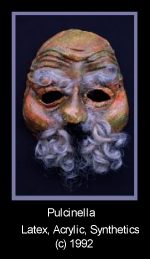 |
Patricia Jane St. John Danko
(C) 2000 |
 |
|